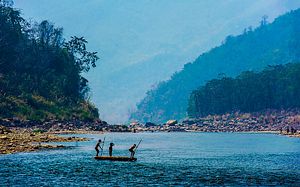Often romanticized as the “seven sisters,” the Indian states of Arunachal Pradesh, Assam, Meghalaya, Manipur, Mizoram, Tripura, and Nagaland, collectively composing the northeast of India, have lagged behind the rest of the country in terms of connectivity and infrastructure. A combination of factors like undulating and difficult terrain, forested areas, and civil, political, and border conflicts have contributed to this lag. Since December last year, the Bharatiya Janata Party government has made promises to expand infrastructure in these areas. Moreover, in the wake of the recent Bay of Bengal Initiative for Multi-Sectoral Technical and Economic Cooperation (BIMSTEC) summit, these promises might finally see fruition.
In December 2015, the Indian government announced that more than 4,000 kilometers of roads and highways were to be constructed in the northeast region over the next few years to improve connectivity. The National Highways and Infrastructure Development Corporation Ltd. (NHIDCL) subsequently began five projects in Arunachal Pradesh and intends to roll out 18 over the states of Tripura, Meghalaya, and Arunachal Pradesh together. In February 2016, Union Minister Nitin Gadkari announced road projects in Assam as well, acknowledging that connectivity was the region’s biggest problem and taking the stand that prosperity would follow the development of roads. He proposed that approximately 150,000 workers would be locally employed over the year for road construction with a specific focus on highways. Furthermore, in March, the Japan International Cooperation Agency (JICA) pledged Overseas Development Assistance (ODA) loans to improve highways in the region.
While Meghalaya and Assam are moving relatively faster along this spectrum, the next push toward this region came in the form of an announcement in July 2016 by the Railway Ministry to reach all state capitals by March 2020 and to massively focus on intra-region rail connectivity as well. Then, in September 2016, the government gave final approval to make good on its promises from the previous year, sanctioning 4,844 kilometers of roads in the northeast under the Special Accelerated Road Development Program (SARDP).
In the past few years, bilateral ties between India and Bangladesh have been re-emphasized as well and Myanmar is emerging as a significant actor in the Bay of Bengal region too. This opens up the possibility that the region may well become a growing nexus of international trade and commerce. At the Northeast Connectivity Summit in the city of Agartala in September, for instance, Bangladesh’s Industry Minister Amir Hossain Amu spoke of his government’s desire to bring substantive changes in terms of connectivity with India. This means that northeast infrastructure development could become the key to establishing strategic links in the region.
Specifically in the context of the BIMSTEC summit, this region becomes important. BIMSTEC leaders discussed speeding up the process of building multi-modal connectivity physically in the region at the October 2016 summit. These initiatives together also open up the possibility of extending port connectivity from the Bay of Bengal to the currently landlocked northeastern states through transit facilities offered by Bangladesh. With the central government’s promises and BIMSTEC’s goals lining up in the region’s favor, 2017 may see the escalation in infrastructural development that the region and its leaders have long sought.

































